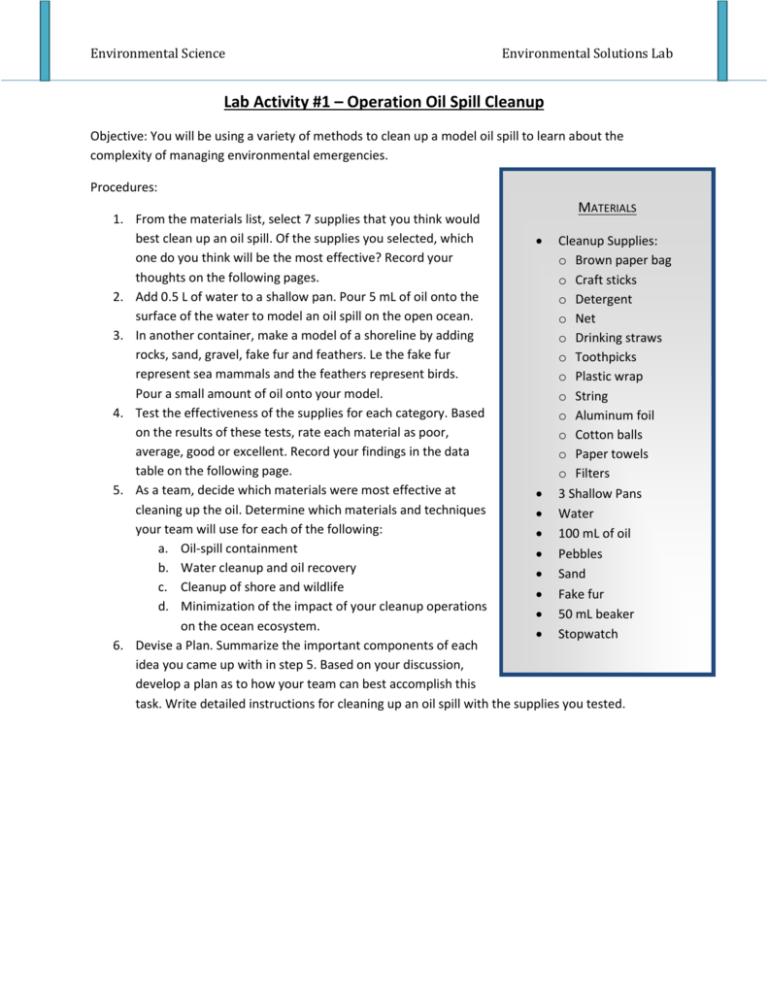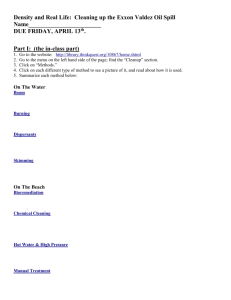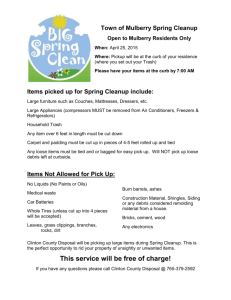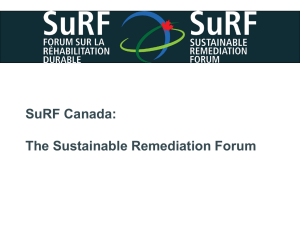Environmental Science Environmental Solutions Lab
advertisement

Environmental Science Environmental Solutions Lab Lab Activity #1 – Operation Oil Spill Cleanup Objective: You will be using a variety of methods to clean up a model oil spill to learn about the complexity of managing environmental emergencies. Procedures: MATERIALS 1. From the materials list, select 7 supplies that you think would best clean up an oil spill. Of the supplies you selected, which Cleanup Supplies: one do you think will be the most effective? Record your o Brown paper bag thoughts on the following pages. o Craft sticks 2. Add 0.5 L of water to a shallow pan. Pour 5 mL of oil onto the o Detergent surface of the water to model an oil spill on the open ocean. o Net 3. In another container, make a model of a shoreline by adding o Drinking straws rocks, sand, gravel, fake fur and feathers. Le the fake fur o Toothpicks represent sea mammals and the feathers represent birds. o Plastic wrap Pour a small amount of oil onto your model. o String 4. Test the effectiveness of the supplies for each category. Based o Aluminum foil on the results of these tests, rate each material as poor, o Cotton balls average, good or excellent. Record your findings in the data o Paper towels table on the following page. o Filters 5. As a team, decide which materials were most effective at 3 Shallow Pans cleaning up the oil. Determine which materials and techniques Water your team will use for each of the following: 100 mL of oil a. Oil-spill containment Pebbles b. Water cleanup and oil recovery Sand c. Cleanup of shore and wildlife Fake fur d. Minimization of the impact of your cleanup operations 50 mL beaker on the ocean ecosystem. Stopwatch 6. Devise a Plan. Summarize the important components of each idea you came up with in step 5. Based on your discussion, develop a plan as to how your team can best accomplish this task. Write detailed instructions for cleaning up an oil spill with the supplies you tested. Environmental Science Environmental Solutions Lab Lab Activity #1 – Operation Oil Spill Cleanup – Data Form 1. What material do you think will be the most effective at cleaning up an oil spill? ______________________________________________________________________________ 2. After testing each of your 5 materials categorize each of them in the table below. Water Cleaning Oil-spill Shore Wildlife Environmental Cleanup & Material Containment Cleanup Cleanup Impact Oil Recovery 3. Was it possible to recover any of the oil? Could the recovery method that was most effective be used in a real oil spill? ______________________________________________________________________________ 4. What happened when the oil reached the beach? How effective was the cleanup of sand and wildlife? ______________________________________________________________________________ ______________________________________________________________________________ 5. What factors might make a real cleanup different from your simulation? ______________________________________________________________________________ ______________________________________________________________________________ 6. In a real oil spill, how might cleanup methods affect animal life? ______________________________________________________________________________ ______________________________________________________________________________ Environmental Science Environmental Solutions Lab Lab Activity #2 – Recycled Paper Objective: You will be exploring how paper can be recycled into usable paper. Procedures: 1. 2. 3. 4. 5. 6. 7. 8. 9. 10. 11. 12. 13. 14. Remove the lid from the blender Make sure the blade is inserted into the blender. Fill the blender halfway with water and add a handful of the soaked paper. Place the blender cover on and lock it by twisting the cover clockwise. To make the pulp, turn the crank of the blender 3 minutes or until the mixture has the consistency of thick soup. Pour water into the tray so that it is up to the full line; add two or three handfuls of pulp. Attach the deckle with the shape you like over the mesh frame, inserting slots on deckle into tabs. Scoop pulp mixture onto the mesh frame with frame tabs facing up. Hold the frame underwater and gently move it back and forth until the mixture is evenly saturated. a. Keep the pulp layer thing for better paper Lift the frame out of the water, allowing the water to drain back into the tray. If you used a deckle, carefully remove it from the mesh frame. Cover the mesh frame with the cleaning cloth, hold securely and flip it over. Be careful not to touch the mesh frame to avoid putting a hole in your paper. Remove excess water by gently pressing down on the paper with a sponge. Remove the mesh frame by carefully lifting it off the paper. Place the cleaning cloth with the paper onto the bottom press plate. Cover it with another piece of cleaning cloth. Place the upper press plate with the smooth side down onto the lower press plate bolts. Attach the nuts onto the bolts and tighten to squeeze out as much excess water as possible. Remove the nuts, the upper press plate and the top cleaning cloth. Allow the paper to dry undisturbed for at least 24 hours. When the paper is dry gently separate the paper from the cleaning cloth. Use your new recycled paper to get creative! Environmental Science Environmental Solutions Lab Lab Activity #2 – Recycled Paper Data Form 1. Did you color your paper? If so, what color was it? 2. Did you use a shaped deckle? If so, what shape? 3. What are the benefits of recycling paper? 4. What are the risks of recycling paper(think outside of this experiment, think big picture/real world)? 5. Would you continue the practice of recycling paper? Environmental Science Environmental Solutions Lab Lab Activity #3 – Water Filtration What is the best way to turn dirty water into clean water? Test some different types of materials to find out! Directions: Using the materials that are in the group bucket, you and your table partner are to select 5 items that you feel would be the best items to use to filter water. These 5 items will be the only things you may use in putting together your device. Once you’ve selected your materials you and your partner are to assemble your filtration system. It may appear in any shape, size or color you find fit. The only stipulations are that it must have an inlet for water and must sit on top of a beaker to collect the filtered water. The winning apparatus will be determined by the effectiveness of the filters ability to reduce the following levels in the water sample by the greatest amount: Total Chlorine, Free Chlorine, Total Hardness, Total Alkalinity, pH, color and particulates present. Environmental Science Environmental Solutions Lab Lab Activity #3 – Water Filtration – Data Form 1. List the 5 materials used to create your water filter. ______________________________________________________________________________ ______________________________________________________________________________ 2. Sketch your filter. 3. Was your filter successful at ‘cleaning’ the water? What were your before and after readings? ______________________________________________________________________________ ______________________________________________________________________________ 4. Why was it necessary for these devices to be created? ______________________________________________________________________________ ______________________________________________________________________________ 5. What could you do to reduce the need for water filtration systems? ______________________________________________________________________________ ______________________________________________________________________________ Environmental Science Environmental Solutions Lab Lab Activity #4 – TED Talk Video Objective: This station is designed to bring more awareness to global issues. You will be viewing another Al Gore TED Talk over global issues. Procedures: 1. 2. 3. 4. 5. 6. To view the video you will be going to my website http://msescience.weebly.com Click on the Environmental tab Scroll toward the bottom to the In-Class Work section You will find the Al Gore video to the right of the Environmental Solutions Lab. Watch the video. Answer the questions on the next page. Environmental Science Environmental Solutions Lab Lab Activity #4 – TED Talk Video – Response Respond to the following question using what you have viewed in the TED Talk video: “Al Gore: Averting the Climate Crisis”. 1. What actions can you, your family and other individuals take, that have been provided by Al Gore, to help avert the climate crisis (hint there are 15)?










